skip to main |
skip to sidebar
My first trip on the Circle Line in Yangon, back in 2008 (described in the post The Circle Line, Yangon) allowed me to identify the main locomotive works of Myanma Railways at Insein, a few miles north of downtown Yangon.
It was not until 20th September 2012 that I discovered that there was a second locomotive works at Ywa Taung (not too far from Mandalay). I'd been with the Doctor to make donations to the Monastic School at Taung Be Lar (described in the post Mandalay) and we took a different route returning which took us past Ywa Taung Station. We stopped and I took a number of pictures which are in the album here (together with additions from later visits).
The Rangoon Guide Map of 1930 (published under the direction of Brigadier R. H. Thomas D.S.O., Surveyor General of India) shows the Works, to the west of Insein railway station.
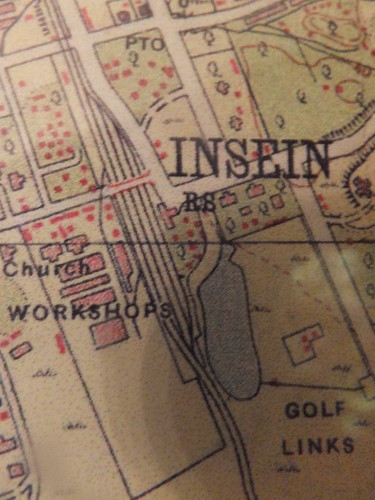
1930 Map of Insein area (more pictures of the 1930 map are here).
On subsequent Circle Line Trips I'd looked 'over the wall' at Insein Works but it was not until my friend, the Doctor, obtained permission for a visit on the 6th May 2015 that I was able to gather more information.
Visit to Insein Locomotive Works
We reported to the Time Office at the Main Gate and were welcomed by the Works Manager before one of his staff took us on a tour of the Works. Despite the urban environment, we first passed through a pleasant landscaped area with a concrete sports ground on our left.
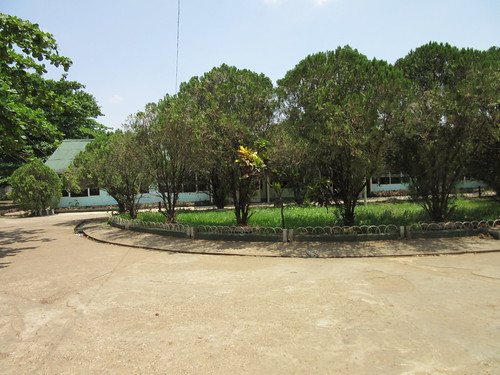 The landscaped area near the main gate.
The landscaped area near the main gate.
However, we quickly passed into a more unkempt but attractive wooded area with a number of diesel locomotives either awaiting 'shopping' or cannibalisation for spare parts.
 DF.1318 (and others) slumber beneath the trees in Insein Works Yard.
DF.1318 (and others) slumber beneath the trees in Insein Works Yard.
Nearby, I found the remains of a number of cut-up steam locomotives. As a dyed-in-the-wool steam enthusiast, I regret the loss of any steam locomotive but it has to be said that there is great educational value in being able to see the internal construction of these machines.
 Insein Works: Cut-up steam locomotives.
Insein Works: Cut-up steam locomotives.
Overlooking this scene of destruction was a plinthed outside-cylinder 0-6-0 oil-burning saddle tank, running number SL3 and gaily-painted.
 Plinthed SL3 at Insein Works.
Plinthed SL3 at Insein Works.
The principal business of Insein Works is carrying out heavy repairs on the fleet of diesel electric and diesel hydraulic locomotives. This task is shared with Ywa Taung Locomotive Works. Insein also carries out re-engining and rebuilding as necessary. The main works at Insein comprises two large, parallel, interconnected bays: the Machine Shop and the Erecting Shop.
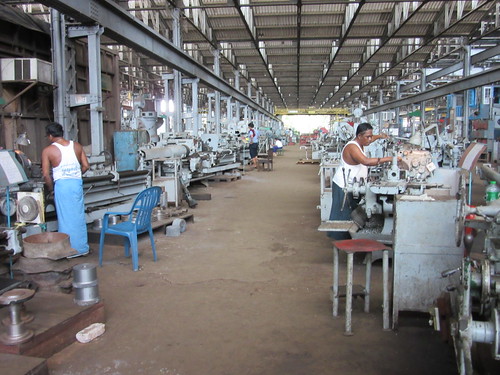 The Machine Shop.
The Machine Shop.
Most of the machines are British and date from the immediate post-World War II period. Burma Railways emerged from the war in a particularly weakened condition and, although Britain initially provided assistance, the coup which led to military rule had the effect of largely isolating Burma from foreign aid until recently.
 Part of the Erecting Shop, looking north.
Part of the Erecting Shop, looking north.
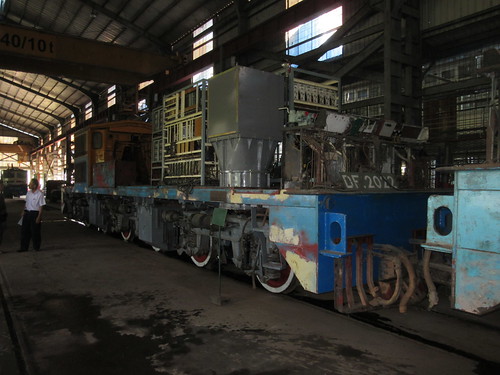 DF.2022, showing racks of electronics.
DF.2022, showing racks of electronics.
A number of the locomotive classes I'm familiar with were visible, in various states of 'undress', but my attention was drawn to a locomotive with a very large cab. This was a rebuild by Insein of a Japanese class DD-51.
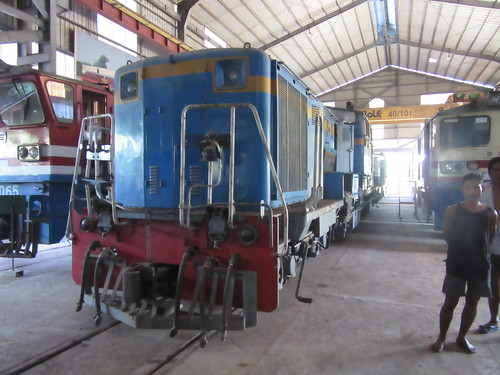 Part of the Erecting Shop, looking south, showing rebuilt Japanese DD-51 locomotive.
Part of the Erecting Shop, looking south, showing rebuilt Japanese DD-51 locomotive.
In its original form, this diesel hydraulic locomotive class had two 1100 h.p. engines and was carried on six axles with the two axles under the cab unpowered (B-2-B), giving an overall length of 18 metres! Designed for freight and passenger use, I believe the large cab originally accommodated a steam boiler for train heating. There's a Wikipedia article here.

DD-51 as originally built (By ja:User:出々 吾壱, via Wikimedia Commons).
I wasn't able to make a detailed study, but Insein appear to have removed one engine and power bogie, producing an 1100 h.p. variant.
I was delighted to find one steam locomotive under active restoration with, apparently, another to follow. I was told that they had already 'outshopped' one restored steam locomotive which is now available for tourist trains in the Bagan area.
 The frames of a 2-8-2 being aligned, using traditional methods.
The frames of a 2-8-2 being aligned, using traditional methods.
I made a rapid tour of the Scrap Line outside, recording what I could.
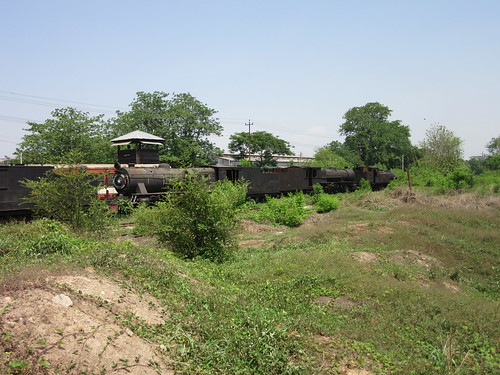 Part of the Scrap Line at Insein.
Part of the Scrap Line at Insein.
I reluctantly concluded my tour, impressed by the ingenuity, professionalism and friendliness of the staff. Before I left, the Works Manager gave me a copy of a booklet 'Brief Information of Insein Locomotive Workshop', updated to April 2015.
My pictures
Insein Locomotive Works, Yangon.
Insein Locomotive Works: Machine Shop.
Insein Works: Cut-up steam locomotives.
Insein Works Scrap Line.
Restoring steam locomotives at Insein.
Plinthed SL3 at Insein Works.
[Text, pictures and 1930 map added 25-May-2015]
My first trip on the Circle Line in Yangon, back in 2008 (described in the post The Circle Line, Yangon) gave me a tantalising glimpse of the extensive sidings in the Mahlwagon Area (just north of downtown Yangon).
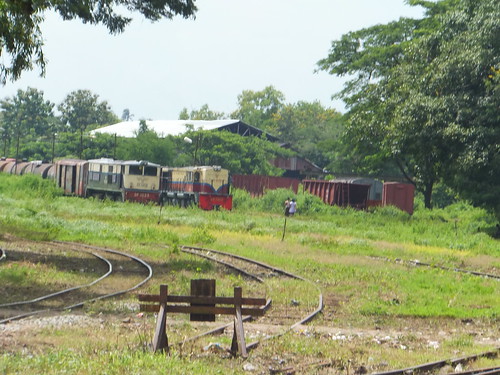 The northern end of Mahlwagon Marshalling Yard, viewed from a Circle Line Train in 2012.
The northern end of Mahlwagon Marshalling Yard, viewed from a Circle Line Train in 2012.
Studying the satellite photographs on Google confirmed the complexity of the infrastructure and revealed a large roundhouse. Later, I found the Rangoon Guide Map of 1930 (published under the direction of Brigadier R. H. Thomas D.S.O., Surveyor General of India) which gave more detail of the facilities and suggested that the yard was probably once far busier serving the extensive docks than at present.
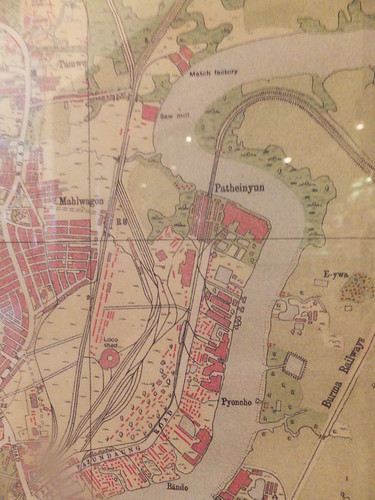
1930 Map of Mahlwagon area (more pictures of the 1930 map are here).
Road access to the area appeared limited and my various explorations of Yangon on foot failed to reach as far as this interesting district. But my friend, the Doctor, obtained permission for us to visit what is still a Restricted Area on the 6th May 2015.
Visit to Mahlwagon Marshalling Yard
We reported to the Yardmaster's Office, where we were made welcome by the Yardmaster and his staff.
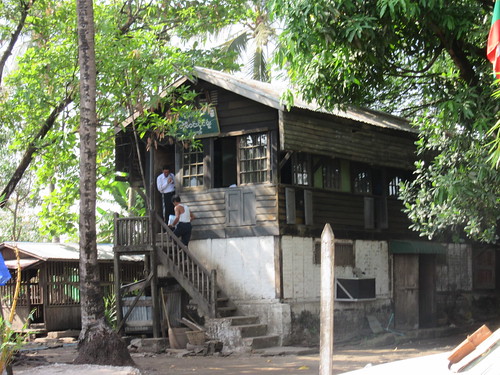 The Yardmasters Office.
The Yardmasters Office.

The Yardmaster.
My attention was immediately drawn to a large, painted diagram of the yard.
 Down Yard with main lines (top) and Locomotive Shed (top middle).
Down Yard with main lines (top) and Locomotive Shed (top middle).
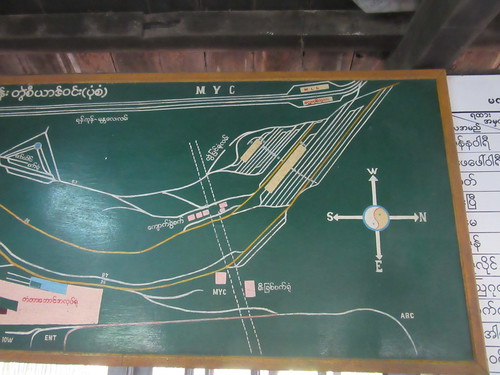 Up Yard with main lines (top) and Mahlwagon Station (top right).
Up Yard with main lines (top) and Mahlwagon Station (top right).
The access road crossed a number of lines in between the Down and Up Yards on the level and DD.521 was shunting at the south end of the Up Yard so, every time the locomotive drew out a raft of wagons, the access road was blocked.
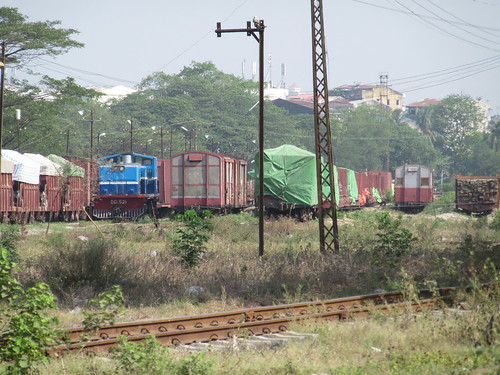 View from the access road looking north, with DD.521 shunting the Up Yard.
View from the access road looking north, with DD.521 shunting the Up Yard.
Once over the lines, there was a large pool on the left, then a housing colony of what I presumed were railway workers. In addition to the houses, we passed a railway medical clinic before we arrived at the gate of the diesel shed.
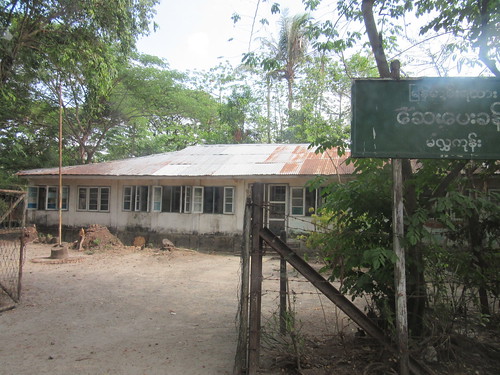 Mahlwagon Marshalling Yard: The Railway Clinic.
Mahlwagon Marshalling Yard: The Railway Clinic.
Visit to Mahlwagon Diesel Locomotive Shed
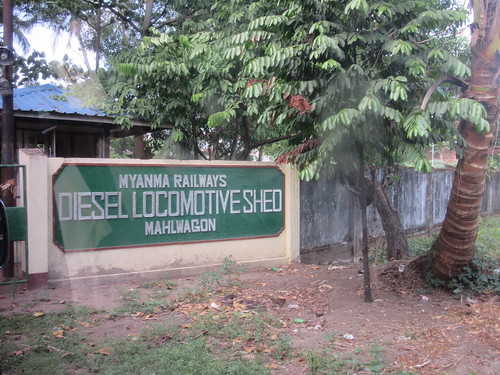 The entrance to the Diesel Locomotive Shed.
The entrance to the Diesel Locomotive Shed.
We entered the yard and followed the road through the trees. On the right, I spotted the plinthed saddle tank steam locomotive I'd seen on my first ride on the Circle Line, on 7th March 2008. On our left, we passed a number of the 1100 h.p. Chinese locomotives in green livery, looking as if they'd been laid aside. DD.1112 and DD.1128 were amongst them. We parked near railcar RBE.30.01 which I'd seen around Yangon. The man from the Yardmaster's office who'd accompanied us made introductions to the Shed Foreman who took us into the shed and immediately started a tour. We were in a 2-track extension to the roundhouse which appeared to serve as the arrival and departure area. Outside, the two tracks gave access to the goods lines at Pazundaung and Yangon Central station. A structure between the two tracks supported a header tank with flexible discharge hoses. On one side, there was a large silver-painted tank farm, presumably for fuel, behind a wall or bund. Two portable compressors could be seen.
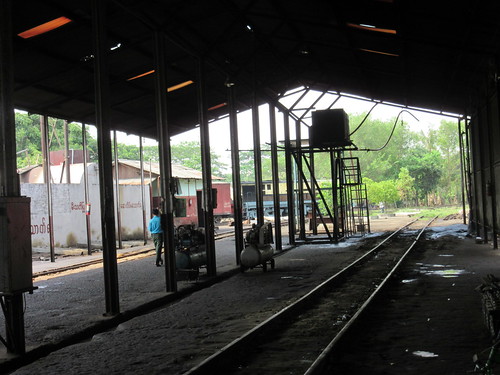 The 2-track extension.
The 2-track extension.
A large sign in Burmese and English read "I WILL BE ALWAYS SURE". We entered the roundhouse itself, a large structure with the roof supported by elaborate steel trusses and a single, curved wall on the outside with regular large, glazed windows. The roof was split into two pitched sections joined by a vertical, glazed section. In a roundhouse, of course, the individual roads radiate from a turntable which was visible outside. Within the roundhouse, each road was provided with an inspection pit. In most cases, the pit was wider than the track gauge and the rails were supported on a series of steel and concrete pillars giving good access for maintenance but, on some roads, the pit was of the traditional pattern, with the width limited by the track gauge. Some roads were provided with a permanent access platform with steps, allowing staff to work at running plate level. Each road terminated in a rail-built stop.
 Mahlwagon Roundhouse, looking anti-clockwise from the arrival/departure roads.
Mahlwagon Roundhouse, looking anti-clockwise from the arrival/departure roads.
 Mahlwagon Roundhouse, looking clockwise from the arrival/departure roads.
Mahlwagon Roundhouse, looking clockwise from the arrival/departure roads.
We walked anti-clockwise from the arrival/departure roads and I made a note of the roads and the stabled locomotives:-
DF.2058, DF.1348, DF.1637, DF.1358, DF.1339, DF.1347, (empty), DF.2017, DF.1239, DF.2066, DF.1200.02, DF.1317, DF.2061, (empty), DF.1349, (empty), DF.1201, (empty), DD.517.
We then moved outside the shed, where the attraction was two steam locomotives laid aside - a coal-burning 'Pacific' (pictures here) and ST772, a 2-6-4 tank engine arranged for oil burning (pictures here). I'll describe these locomotive classes later.
We walked back through the shed to reach the turntable, a 120-ton 'Mundt' type supplied in 1946 by Ransomes and Rapier Limited, Ipswich. It appears to be 65 feet diameter. Although the turntable is electric, various problems mean that it presently has to be hand-operated. In a roundhouse, every locomotive arriving or departing has to be turned on the turntable to access the required road so the lack of electric operation is very inconvenient.
We watched DF.1637 on and off the turntable. This locomotive was uprated to 2000 h.p. when an MOI 16V170 engine was fitted by Insein in 2013. Wärtsilä and Cummins had a short-lived joint venture which I believe originally produced the 16V170.
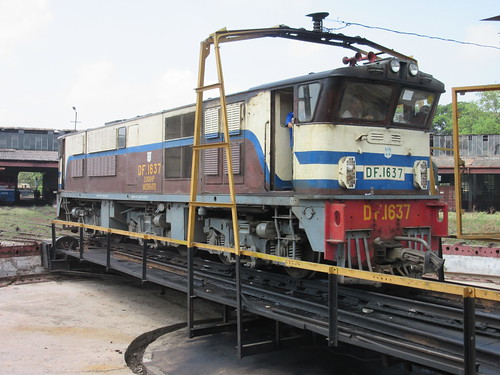 DF.1637 on the turntable at Mahlwagon.
DF.1637 on the turntable at Mahlwagon.
We briefly looked at a building under construction with a high roof served by a single siding not radiating from the turntable. The structure was fitted with overhead travelling crane rails so I presumed that this was intended to give the shed improved lifting facilities in the future.
 New building awaiting fitting-out.
New building awaiting fitting-out.
Our attention then turned to the 'clockwise' part of the shed which appeared to be involved in more major repairs. Outside the shed we found an Engineer's Rail Gang Car numbered ED/RGC.100, DF.1345 (an Alco-designed locomotive purchased second-hand from India fully refurbished), DD.1114 and DD.1119, both in Green livery, allocated to Mandalay and looking rather sorry for themselves.
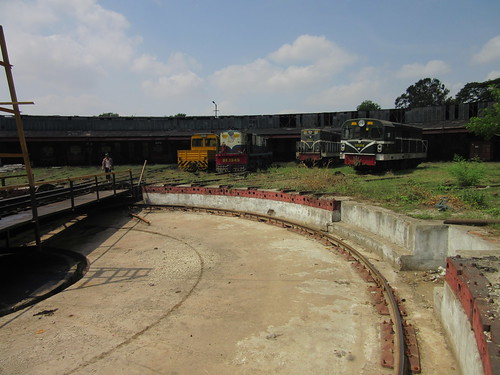 Mahlwagon Shed viewed from the turntable.
Mahlwagon Shed viewed from the turntable.
Another 1100 h.p. locomotive was half inside the shed. On the adjacent road, DF.2026 was positioned on four 'GEDI' lifting jacks, presumably for exchanging bogies. GEDI (Gebr. Dickertmann) was founded in Bielefeld, Germany, in 1843 and was acquired by NEUERO Technology GmbH in 1990 forming a world-wide supplier of equipment for the maintenance of railway vehicles. Nearby, DF.1322 was parked. There was a modern Test Bench for JZ6 and JZ7 air brake parts (Chinese designs).
 Test Bench for air brake parts.
Test Bench for air brake parts.
Outside the shed, we found an Orton McCulloch Diesel Crane, running number 45.T.DC.9892. The crane was carried on two six-wheel bogies with the jib supported on a bogie flat wagon. 'ABC' couplers were provided.
We then made our way back through the shed towards the Arrival Roads, where DF.1330 had just come 'On Shed'. As we watched, a second light engine, DF.1351, was just arriving behind DF.1330. Nearby, the Shed Foreman was anxious to show us one of the Japanese one-car railcars, RBE.30.01, externally looking very smart in a mainly-red with cream livery.
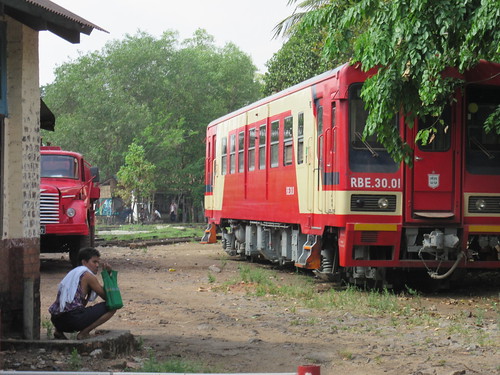 Railcar RBE.30.01 outside the shed at Mahlwagon.
Railcar RBE.30.01 outside the shed at Mahlwagon.
The Shedmaster had offered to meet us after our tour, so we were taken to his office and chatted for a while. One of the topics which was raised was their turntable, and the problems associated with currently having to operate it manually. I was invited to express an opinion and, despite making it plain that I had only limited knowledge of turntables, I found myself being led back to the turntable in order to clamber down into the pit and have a closer look at the mechanism. I'll put the details of my rather informal survey in a separate report.
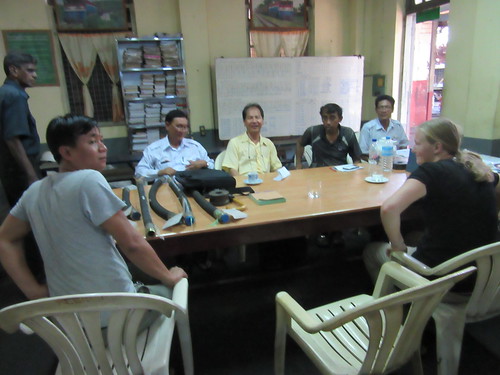 The meeting in the Shedmaster's Office.
The meeting in the Shedmaster's Office.
We then expressed our thanks for a fascinating visit and said our 'goodbyes'. I had just one more task before we drove away - to photograph the diminuitive saddle tank plinthed just inside the shed boundary wall which I'd first spotted on 7-Mar-2008 (that picture is here). Fortunately, the locomotive still carried its Kerr-Stuart worksplate (No. 1284 of 1914) so, on my return to England, I was able to find a little more.
To find out what happened next on this trip, go to the post Yangon (Part 4).
All my posts describing Myanma Railways can be found here.
My pictures
The following albums (on Flickr) contain pictures relevant to this post:-
Mahlwagon Marshalling Yard, Yangon.
Mahlwagon Diesel Locomotive Shed.
Mahlwagon Diesel Shed Turntable.
'Pacific' at Mahlwagon.
Tank Engine at Mahlwagon.
Plinthed Kerr-Stuart at Mahlwagon.
All my pictures showing Myanma Railways can be found here.
[Text and pictures added 1-Jun-2015, 6-Jul-2015]
Events of Wednesday, 6th May 2015
Dr. Hla Tun had managed to arrange for us to visit the Freight Marshalling Yard at Mahlwagon and the Diesel Locomotive Depot also at Mahlwagon Emily accompanied us. We were treated with great friendliness and, of course, I enjoyed myself immensely. A more technical description of our visits (with links to pictures) can be found in the post Mahlwagon Marshalling Yard and Diesel Locomotive Shed, Yangon.
A visit to the main Locomotive Works at Insein had been arranged for the afternoon so, when we left Mahlwagon, the Doctor had to drive across Yangon to Insein. On the way, we stopped for a quick lunch of soft white bread, hot milk and yoghurt at a small roadside cafe which is famous for its milk. Certainly, as we consumed our lunch, they were doing a brisk takeaway business, particularly in milk supplied in plastic bags. There is no standard pasteurisation or sterilisation of milk, so a reliable source of supply is essential. A number of stainless steel churns were standing on the pavement and, as I watched, these presumed 'empties' were loaded into a taxi, a dignified gentleman with a beard climbed into the passenger seat and the taxi drove off, I assumed to obtain more milk.
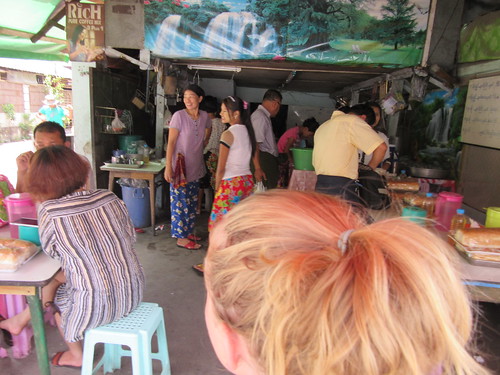 'Milk Bar', Yangon-style.
'Milk Bar', Yangon-style.
After our meal, we continued to the Locomotive Works for our afternoon visit. Once again, we were made very welcome and I had a great time trying to grasp all the activities. There's a more technical description of our visit to Insein (with links to pictures) in the post http://janfordsworld.blogspot.co.uk/2015/05/insein-locomotive-works.html.
There was one final piece of business. We drove to the Palae Metta Home which has about 20 orphans, boys and girls over a wide age range. It was built by and now operates in honour of the memory of Isabel and Lawrence Barnett and Bob Jennings. For the last three years, running costs have been met by a German charity. Dr. Hla Tun supports the home as possible and we brought clothing and stationery which was gratefully received.
The boys and girls performed a song for us before we left. There's a short video of the song here. After seeing the video, the 'Back Button' will return you to this post.
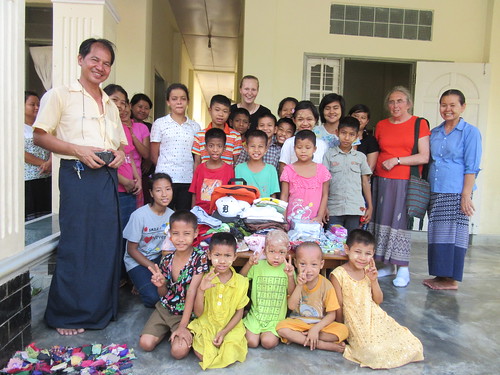 Smiling faces at the Palae Metta Home.
Smiling faces at the Palae Metta Home.
Events of Thursday, 6th May 2015
On Thursday, I was picked up from the Strand Hotel at 05:15 to go to Mingalardon Airport for my Qatar Airways flight to Doha where I transited to another Qatar Airways flight to Manchester, England. 'Burma-2015' was quite a trip!
My posts
All my posts on this trip to Myanmar can be found here.
My pictures
The following albums (on Flickr) hold pictures relevant to this post:-
Around Yangon, 2015.
Palae Metta Home, Yangon.
All my albums for this trip (except purely 'technical' ones) can be found here.
[Text and Links amended 31-May-2015]
Events of Tuesday, 5th May 2015
I'd been invited to join the team from Pencils for Kids, Inc. distributing backpacks with uniforms/robes and items of stationery at two Nunneries in the Yangon area.
Pencils for Kids, Inc. was founded by Retta Jitner, the current President, in 2007. It operates in Myanmar, Bali and Thailand.
The Doctor, Emily and I met Retta, accompanied by four American ladies from her group, at their hotel the Belmond Governor's Residence. Since they were generally wearing blue polo shirts with the 'Pencils for Kids' logo and white baseball caps also with the 'Pencils for Kids' logo, they looked quite impressive. Doctor Hla Tun was similarly attired but Emily and I were in plain T-shirts with longyi. We travelled in an air conditioned coach with driver, assistant and two local guides. A small pick-up truck with seats followed with the actual items to be distributed.
 'Pencils for Kids' team at the Belmond Governor's Residence, Yangon (Retta was taking her own photograph of the group).
'Pencils for Kids' team at the Belmond Governor's Residence, Yangon (Retta was taking her own photograph of the group).
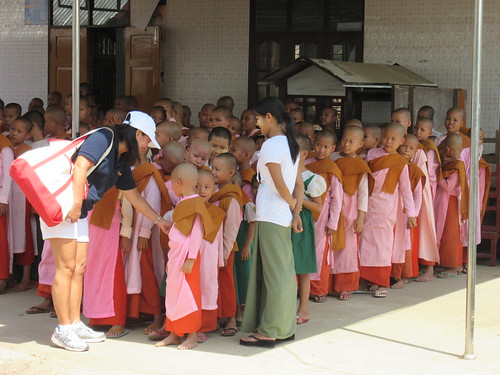 Retta at Syriam Nunnery.
Retta at Syriam Nunnery.
In the morning about 200 sets of backpacks (with 'Pencils for Kids' logo), uniforms/robes and items of stationery were distributed at the Syriam Nunnery.
 The 'Group Shot'.
The 'Group Shot'.
After lunch in a private dining room at a nearby restaurant, we drove a little further out of the city to a smaller Nunnery. The approach road was too narrow for the coach so we travelled the last few hundred yards in the pick-up truck.
 The young nuns sang for their visitors.
The young nuns sang for their visitors.
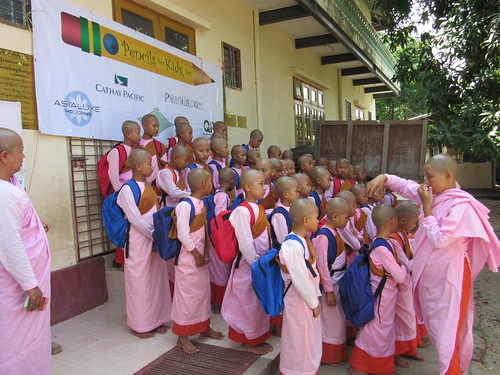 After the presentations, the 'Group Shot'.
After the presentations, the 'Group Shot'.
 The 'Pencils for Kids' team.
The 'Pencils for Kids' team.
The coach drove us all back to Yangon and we said 'good bye' to our friends from 'Pencils for Kids'.
Go to next post on this trip.
All my posts describing this trip to Myanmar can be found here.
My pictures
The following albums (on Flickr) hold pictures relevant to this post:-
'Pencils for Kids' at the Syriam Nunnery, Yangon.
'Pencils for Kids' at a Yangon nunnery.
Around Yangon, 2015.
All my albums for this trip (except purely 'technical' ones) can be found here.
[Text amended and pictures added 31-May-2015]
Events of Monday, 4th May 2015 (continued)
In the previous post, Yangon (Part 1), I promised to tell you about a rather surreal incident. There I was, unexpectedly enjoying a cab ride on Yangon's 'Circle Line' and taking plenty of photographs. At one of the frequent station stops, a man joined the train and came into the cab. I took him to be some sort of railway inspector because he carefully checked the logbook being assiduously completed by the Secondman (Assistant Driver). We exchanged smiles and he took one or two calls on his mobile phone. Answering another call, he passed the phone to me and said "It's for you". To say I was surprised is an understatement. A man's voice on the phone said that he had some answers to my questions. As we were travelling, I couldn't hear very well and I didn't get his name. I concluded that my mystery caller must have been recruited by my friend Htein Lin to help answer some railway technical questions I'd asked the previous Saturday. It was only that evening that Htein Lin explained to me that he had, indeed, asked his friend Zaw Lin to help and that Zaw Lin is a train driver on the Circle Line. So, I suppose Zaw Lin had been on one of the trains we passed and had recognised me and the railway inspector and decided to make contact. But it was a very odd experience! When we arrived back at Yangon Central Station, I said 'goodbye' to my new friends and walked back to the Strand Hotel, pausing on the way to buy second-hand books in English from a series of street sellers offering books on all sorts of topics.
A shower and a drink at the hotel re-vitalised me, so I set off again on foot, going east along Strand Road before turning north for a few blocks, crossing a number of main roads (Merchant Road, Maha Bandula Road and Anawratha Road) before turning east again on Bogyoke Road.
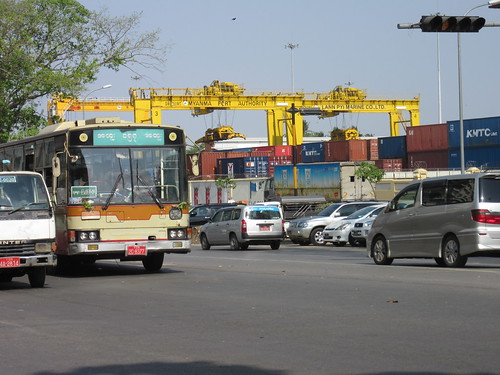 Strand Road, looking towards the docks.
Strand Road, looking towards the docks.
A slightly more aggressive method of crossing roads seemed to be indicated. In Myanmar, vehicles are allowed to turn right against traffic lights so pedestrians wait in vain for an 'all red phase'. Rather, you cross roads one lane at a time, pausing (with traffic passing both in front and behind you) until there's a space between vehicles in the next lane and so on.
I passed Saint Mary's Roman Catholic Cathedral, completed in 1899 and the largest in Myanmar.
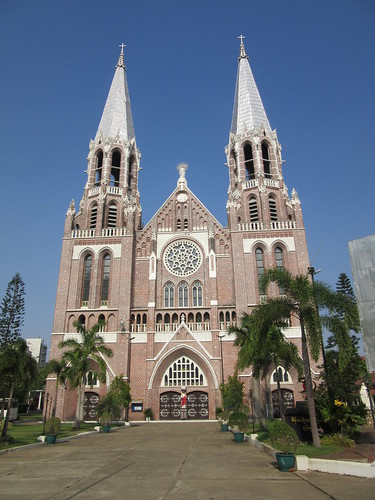
Saint Mary's Cathedral.
The route I was on was one I'd taken a couple of years ago, described in the post Back to Yangon.
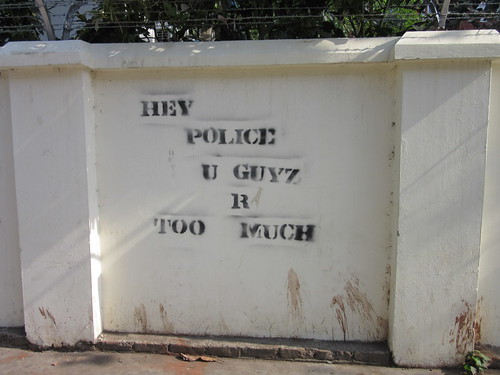 Textspeak meets Irony?
Textspeak meets Irony?
The Yae Kyaw apartment complex being built was a new development since 2013. Health and Safety for the construction workers didn't seem quite as rigorous as back home.

The Yae Kyaw apartment complex under construction.
Another new development, less permanent than the Yae Kyaw Complex, was a section of the road which has spawned numerous stalls which all seemed to be offering identical fold-up 'gazebos' and large umbrellas.
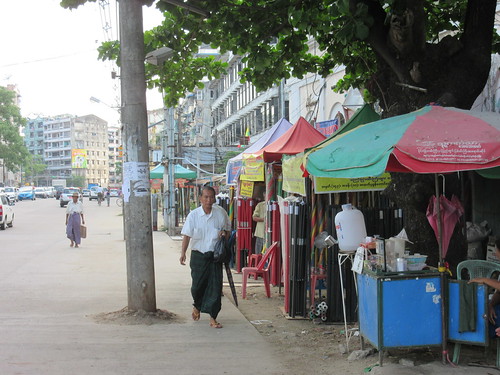 Fold-up 'gazebos' and large umbrellas for sale.
Fold-up 'gazebos' and large umbrellas for sale.
Back in 2013, I'd reached Pazundaung railway station (one station east of Yangon Central railway station) and, exhaused, decided to catch a train back. This time, I'd hoped to get beyond Pazundaung, towards Mahlwagon but, by the time I'd reaching Pazundaung station, I was, once again, ready to catch a train back. The kindly station master was worried that I wasn't aware that I was only one station from Yangon Central but, once satisfied, he had his booking clerk issue a ticket costing just 50 Kyats.
Various trains came and went before the one I'd been directed to. I was worried by a group of four ladies sitting on the rails of the anti-clockwise Circle Line, apparently oblivious to the possible approach of a train.

However, before a train arrived on that line, they'd been joined by quite a crowd of passengers.

At last my own train arrived. The train was packed but there was room to stand on the step inside the doorway (many Circle Line coaches are without doors, so it's as well to hold tight to the grab rail. In contrast, the "new" Japanese trains are the height of sophistication, with driver-controlled air operated sliding doors). On arrival at Yangon Central, I indulged in a taxi (yes, a proper 4-wheeled saloon) to return to the Strand Hotel. Once in my comfortable room, I didn't venture out again that evening.
I've deliberately excluded railway technical discussions from this post but I'm sure I'll add a more technical write-up later.
The next day, I'd been invited to join the team from 'Pencils for Kids' distributing backpacks with uniforms/robes and items of stationery at two Nunneries in the Yangon area.
Go to next post on this trip.
All my posts describing this trip to Myanmar can be found here.
My pictures
The following albums (on Flickr) hold pictures relevant to this post:-
The Circle Line by DMU.
DMU Cab Ride on the Circle Line.
Around Yangon, 2015.
The Circle Line, 2015.
All my pictures for this trip (except purely 'technical' ones) can be found here.
[Pictures added 31-May-2015]
Events of Monday, 4th May 2015
According to the 'welcome' letter from the General Manager of the Strand Hotel, it was built in 1901 by John Darwood (presumably the same family also mentioned in my post Rangoon Tramways) but was subsequently acquired by the Sarkies brothers. Regarded as the "finest hostelry east of Suez" it was said to be patronised by "royalty, nobility and distinguished personages". Certainly, Rudyard Kipling (see my post Kipling's Burma), George Orwell, Somerset Maugham and Noel Coward stayed here.
I had an excellent night's sleep and took breakfast in the Strand Cafe with views of the busy Strand Road. I decided to walk to Yangon Central Station and take a trip on the fascinating 'Circular Railway'. Leaving the hotel, the first change I found within a few yards of the hotel was a covered concrete footbridge which has appeared since my last visit linking the north side of Strand Road (the hotel side) with the road to the Dalla ferry terminal. Many people who work in Yangon actually live in Dalla, the other side of the Yangon River. In 2009 I described a fascinating visit I made to Dalla in the post Ferry to Dalla. Each end of the new footbridge has both steps (for descending pedestrians) and a Schindler escalator for going up. There's a third set of steps leading to the south side of Strand road but these are not provided with an escalator. The bridge offers some new angles for photographs. A number of women were attempting to keep the bridge clean, sweeping up the dust and mopping but with the hordes of pedestrians passing in both directions it was a difficult task.
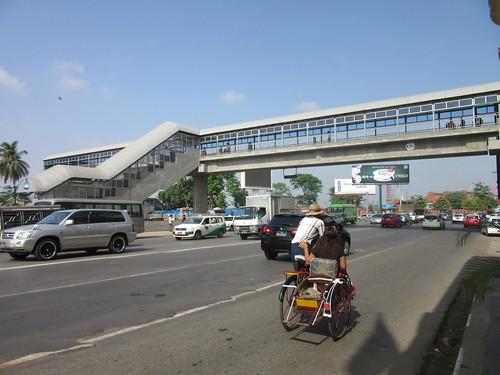 The new footbridge across Strand Road.
The new footbridge across Strand Road.
I also noticed that the area in between the old brick transit sheds and the road to the ferry terminal is being developed but as what, I couldn't determine.
Yangon's electricity supply is still not very secure and the number of commercial premises who find it necessary to provide standby generators has increased over the years. This plant invariably provides another hazard on the already quite difficult pavements. I fondly remember some museum-ready installations with little 'Lister' engines driving a generator via a belt. Today they all seem to be 'packaged' sets of varying size and sophistication, although some of them are rather battered in the way I rather think only the Burmese can achieve.
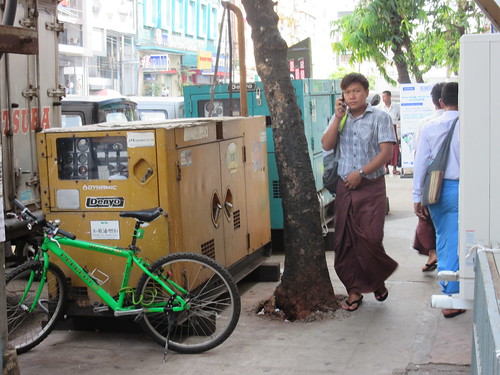 Standby generators mounted on the pavement in Yangon.
Standby generators mounted on the pavement in Yangon.
When I reached Yangon Central Station, I went to the 'Circle Line Tourist' booking office on platform 6/7. Once, tourists had to pay with U.S. Dollars but now they accept Kyat. A complete round trip is 1,000 Kyat (around one dollar). The hand-writing of ticket details, using a duplicate book and carbon paper, has stopped - a pre-printed paper ticket is now used which only requires two rubber stamps to validate it. Long-distance tickets are probably still manually produced. My train was to leave from platform 4, so a member of staff conducted me across two lines to the right platform (the platforms are very low so everybody always walks across the lines, although the station does have a footbridge which, with my British upbringing, I usually feel compelled to use). Assuring me that my train would arrive shortly, my guide returned to the ticket office.
When the train appeared, heading anti-clockwise, I was initially disappointed because it was one of the "new" air-conditioned diesel multiple units from Japan. But these are actually super-annuated units withdrawn from service in Japan, re-furbished and re-bogied for use in Myanmar.
 My train arriving in Yangon, still displaying its former Kururi Line markings in English and Japanese.
My train arriving in Yangon, still displaying its former Kururi Line markings in English and Japanese.
To my surprise, rather than continue anti-clockwise, we set off in a clockwise direction so, to position myself near the front, I had to walk the length of the 5-coach train. Externally, the bodysides have been sold as advertising space so the units look as gharish of some of our English trains. Internally, the original crop of Japanese signage (prohibitions, no doubt) has been re-inforced by Burmese signs. Each coach was provided with a number of oscillating fans, so I wondered if the trains really were "air-conditioned". I was puzzled because about 1 in 3 windows had been opened two or three inches whilst the remaining windows were shut.
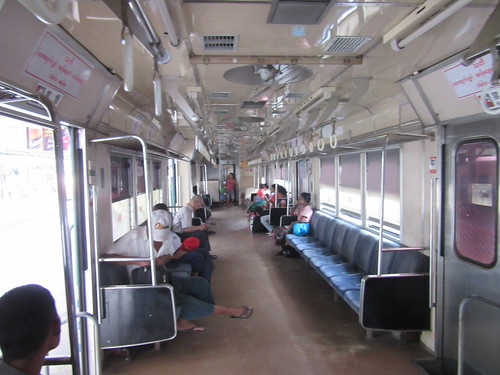 The comparatively luxurious accommodation of the 'new' trains.
The comparatively luxurious accommodation of the 'new' trains.
After about 75 minutes we were about halfway round the Circle Line and the train seemed to be warming up. Train staff came round opening some of the windows fully. They also opened the door to the driving cab and wedged it open with a wooden wheel scotch. Since the gangway door at the front of the cab was already open, when we were moving this produced a good current of air through the train.
I positioned myself near the open cab door for photographic purposes and, seeing my interest, I was invited into the cab and presented with one of the plastic stools to sit on with an excellent view ahead through the open gangway door. I stayed perched on my seat with a broad smile on my face (I must have looked like a sort of garden gnome) until we arrived back at Yangon Central.
Passing another 'new' diesel multiple unit.
There are two short videos showing parts of the journey. The first video shows the train on plain line and can be accessed here. The second video shows the train entering Yangon Central Station after waiting for the signal outside the station and can be accessed here. After watching either video, the 'Back Button' will return you to this post.
There was a rather surreal incident on the journey which I'll describe in the next post.
Go to next post on this trip.
All my posts describing this trip to Myanmar can be found here.
My pictures
The following albums (on Flickr) hold pictures relevant to this post:-
Strand Hotel, Yangon.
The Circle Line by DMU.
DMU Cab Ride on the Circle Line.
Around Yangon, 2015.
The Circle Line, 2015.
All the pictures for this trip (except purely 'technical' ones) can be found here.
[Text amended and pictures added 31-May-2015: Video added 14-Jul-2015: Text amended, pictures and video added 17-Jul-2015]
Events of Sunday, 3rd May 2015
I know I've yet to tell you about part of the Mon State trip, part of the Putao trip and Saturday in Mandalay. I'll go back and fill in the gaps when I can.
I had a decent breakfast at the Sedona and discussed with the staff the possibility of taking a local train somewhere. But I also needed to be ready to leave for the airport at 3 p.m. and there didn't seem to be a feasible trip. Instead, I decided to have a walk to the station to look around.
I left the hotel about 08:00 and the day was already hotting-up with bright sunshine. I deliberately chose a slow gait along the pavement next to the Royal Palace Moat. Walking gives the chance of spotting things of interest and taking photographs. It took me about 45 minutes to reach the station (it is a fair distance). On the way, I saw that Mandalay City Development Committee are having a new steel-framed building put in on their front lawn. It might be some sort of arena with seating. In various places, I saw new reinforced concrete structures being built, generally up to five stories high although a few are much taller. I found one piece of grafitti with the wish "To be peaceful, Motherland". I'm afraid peaceful co-existence of the various ethnic groups and satisfaction with the pace of political change towards a recognisable full democracy still eludes this marvellous country. I passed red brick Methodist and Anglican churches before turning left onto 78th Street. This important street has three lanes in each direction but usually the lane nearest the kerb is avoided by through traffic and it's usually occupied by pedestrians, who normally keep their back to approaching traffic, motor cycles and bicycles going the wrong way, parked vehicles and tradesmen offering various goods to approaching vehicles.
I arrived safely at the impressive station building and went upstairs to look at the two booking offices. All the signs and most of the timetables were in Burmese. The English timetable I located confirmed what the hotel had said. There were supposed to be bi-lingual Burmese/English electronic displays, but I didn't find one working. I decided to have a good walk around the platforms and then circumnavigate the station using public roads. This provided information not only on Myanma Railways but also on the lives of the people.
I saw one long express train from the south arrive, hauled by 1300 h.p. diesel electric locomotive DF.1342. This class comprises refurbished 'YDM4' locomotives from India. As the train rolled into the platform, a series of men jumped onto the train, one to each door. I assumed they were self-employed porters trying to secure clients before the train had even stopped.
Rejoining 78th Street, I continued south, passing the 'Great Wall Shopping Centre' on the opposite side of the street. Then, I took a side street on the right hoping to reach the west side of the station. The street turned left so as to avoid the railway but lots of pedestrians were simply walking across the tracks as if there were a level crossing at that point so I copied their example and, having crossed the tracks, then turned right so that I was heading north on the street to the west of the station. I was definitely on the 'wrong side of the tracks' and the lifestyles of some of the people explained why Buddhists believe that "life is suffering". Numerous people spoke to me, none in an unfriendly manner and nobody tried to sell me anything. At one place, I saw a petrol-driven air compressor and a sheet of plastic rigged over bamboo poles - bingo, instant tyre repair shop. Nearby, a pile of rubbish dumped in the street was being sorted, presumably for reclamation, by a man and woman squatting beside what appeared to be an 'official' council lorry. A group of children were playing beside an open drain full of cloudy water. I passed a couple of concrete cisterns full of water which I assume is the only water supply available to these 'people of the streets'. Some people were washing clothes whilst others were carrying out there personal ablutions.
By the time I'd watched Kawasaki-built 500 h.p. diesel shunter D.512 perform a few shunting moves at the north end of the station, I'd completed my circumnavigation of the station but I was very tired, having been walking in the sun for two and a half hours. As I walked towards the yard in front of the station where I'd have a choice of hiring various forms of transport back to the hotel, a motor cycle taxi pulled up alongside me and offered his services. I think he expected the brush-off, because he looked quite surprised when I asked for a quote. Lady pillion passengers usually (or perhaps invariably) ride side saddle in Myanmar and I was, as usual, wearing a longyi so I had to decide whether I thought I could balance side saddle. The driver kitted me out with a crash helmet (he was already wearing one) and we set off into the traffic. Well, he took it fairly gently and I thoroughly enjoyed the ride back to the Sedona.
I was able to take it easy for a while before getting ready to be picked up at 15:00 for transfer to the airport for the Air Bagan flight to Yangon with an intermediate stop at Nyaung Oo, which I think they've started to call 'Bagan'.
The flight was on time, my bag appeared promptly at Yangon Domestic Terminal and a driver was waiting holding a sign with my name. As usual, traffic was heavy but, on arrival at the Strand Hotel, I received the usual warm welcome.
All my posts on this trip to Myanmar can be found here.
Saturday 1st May 2015
Back in September 2012, I met a train driver in Myanmar called Htein Lin. That meeting was described in the post By Train to Naba. He and I have corresponded by e-mail since then and on 30th May 2014 I spent the day with Htein Lin, his wife and two daughters, described in the post Mandalay Briefly.
We'd agreed to spend some time together on 1st May 2015 and we met up at the Sedona Hotel. The day was a holiday and also a Full Moon in the month of Kason, making it a very auspicious time for a visit to Mingun, home of the 'Unfinished Pagoda' and other important locations.
My first visit to Mingun was during my first visit to Myanmar in 2008, described in the post Round the World Five - Day 6. I went to Mingun a second time in 2010, described in the post Back to Mandalay.
This time, we went by taxi. Now, Mandalay is on the East Bank of the Ayeyarwaddy but Mingun is on the West Bank, a few miles further north. To cross the river, it's necessary to set off going south to Sagaing to get to the only road bridge in the area. So, it's a fair journey and there seemed to be many people apparently making the same journey. We stopped on the way and the driver was despatched to obtain canned drinks from a shop. Apart from the usual carbonated drinks like Coca Coloa and Sprite, energy drinks in 250 mL cans seem popular. There are a number of brands - Red Bull is widely available but, this time, we had 'Shark' (something to do with the drink having 'bite', I think).
A number of the pagodas we passed were soliciting donations from the passing traffic. A public address system is set up at the roadside and an excited male voice exhorts the traveller to generosity. A number of collectors, often young women, stand at the roadside holding out a metal offering bowl to catch the donations. One pagoda we passed was making ready to distribute a free lunch.
After a number of hold-ups on the narrow roads, we arrived at Mingun and parked near the unfinished pagoda. There's a small shrine inside the single entrance at the front and, having removed footwear, we joined the visitors making an act of worship inside. There's a charge levied by the Conservation Department and some work was apparent. Proper brick steps with a handrail now allow visitors to climb to the top of the Unfinished Pagoda in relative safety but we didn't accept the challenge.
We did closely examine the Mingun bell, along with crowds of excited Burmese. It claims to be the "largest uncracked bell in the world", since Moscow's Tsar Bell, whilst larger, has an 11 ton piece broken off and displayed alongside (I described a visit to the Tsar Bell in the post Inside the Kremlin).
We went into a large elderly persons home maintained by donations. My friend explained that he had been a donor here for some time and we went inside one of the ladies' dormitories briefly. The English are reputed to respond generously to appeals for help but, in Myanmar, it is a natural part of being a Buddhist.
There are a number of art galleries at Mingun but there were also a lot more souvenir stalls than I'd seen on my previous visits, all thronged with Burmese enjoying a day out. We took lunch at a large restaurant with views of the Ayeyarwady River and my friend ordered food for me exactly to my taste (steamed rice and non-spicy vegetables).
Then, we set off back south to Sagaing and its road bridge. Approaching Sagaing, we passed the large Wachet Jivitadana Sangha Hospital, opened in 1984 and, apparently, with American connections. Sagaing has a special place in Burmese Buddhism and there are numerous pagodas, monasteries, nunneries, meditation centres and study centres scattered across the hills. It also has narrow, twisting streets which took some time to negotiate as the traffic was still heavy.
When we reached the main road leading to the bridge, we turned away from the bridge towards nearby Ywa Taung. My friend knew that I'd been keen to find more information about the Diesel Locomotive Workshops at Ywa Taung. We drove to the main entrance knowing that the works was completely closed for the holiday. Having made a photograph, we then went to the home of the Divisional Mechanical Engineer, Khin Maung Htun. He graciously received us and gave me a lot of information about the activities of the workshops, using a Powerpoint Presentation. As soon as I can, I'll write a separate, technical post about the Workshops.
We then crossed the road bridge back to the east bank of the river and drove back to Mandalay after a very enjoyable day out. We had soft drinks in 'Planters Bar' at the Sedona Hotel after which I said 'goodbye' to Htein Lin and his family.
I was not quite finished for the day. My friends in Mandalay, the Ko Hlaing and Ma Khaing Family, came round to the hotel. Their charming young daughter is growing up fast and has an amazing command of English. She and I had a walk around the outside swimming pool and she asked questions about everything we saw. I'd last seen the family a year earlier, as described in Mandalay Briefly.
All my posts on my 2015 trip to Myanmar can be found here.
[Actually first posted 6th May 2015, but timestamp amended to place posts in event order]
Events of Friday 1st May 2015
In the afternoon, Aung and I travelled together on Air Bagan Flight W9-424 from Putao to Mandalay with an intermediate stop at Myitkyina. At Mandalay, I disembarked whilst Aung stayed on the flight to return to his home in Yangon. The transfer bus at Mandalay was a very second hand Japanese bus. In the large baggage hall, we waiting some minutes before one on the baggage conveyors started up and started spitting out bags intermittently. I stood despondently as the waiting crowd thinned out having found their bags until I was alone and no more bags emerged. Then, a member of staff came sauntering up pushing my bag which, for some reason, had not been through the baggage conveyor. Once they'd collected my baggage tag, I was able to have all my luggage X-rayed and move into the arrivals hall where I'd spotted my waiting driver. He recognised me and said he'd driven me before. He was driving an air-conditioned Toyota 'Alphard' and, for once, I didn't complain about the air conditioning.
Myanmar is changing quite quickly in some respects. The dual carriageway leading away from the airport has sprouted regular posts which I assume will shortly be fitted with lights. At one of the many traffic islands, a huge filling station is under construction. At one point, extensive blocks of what looked like apartments are being built. At the junction with the road to Sagaing, we took the right fork for Mandalay but, in the background, I could see the silhouette of the Sagaing Hills with the triple arches of the new road bridge. As we approached the city, we passed a toll station which relieved us of 500 kyat (about half a U.S. Dollar) after which are area became built up with commercial and industrial premises lining the dual carriageway. As we came nearer, the traffic sloowed, giving me time to notice large new cantilevered structures carrying traffic lights. I noticed the rather mis-named Prince Airport Hotel - it had taken us 30 minutes from the airport to pass the hotel. As we continued, the shops seemed to be more up-market fashion stores and lots of mobile phone stores. Having passed the railway station, we turned right to run parallel to part of the moat around the former royal palace. Very soon, we were pulling into the forecourt of the Sedona Hotel.
Fortunately, I was expected so, within a few minutes, I was in a comfortable room at the front on the 5th floor, with a splendid view along the palace moat to Mandalay Hill in the background. Rooms at the front are noisier, but I think I prefer the front for the commanding views. I'm at the Sedona for two nights, then I fly back to Yangon for the last segment of my trip before returning to England.
I'm afraid there's been too much going on to write up all that's happened but, sooner or later (probably later) I'll try to complete the story and add pictures.
All my posts on this trip to Myanmar can be found here.
Events of Wednesday 29th April 2015
We’d arranged to explore the Market at around 7 o’clock in the morning.
 Putao Market.
Putao Market.
With appetites whetted by the walk, we returned to Putao Trekking House for breakfast. They’d laid on white toast with butter and preserves followed by a plain omelette for me. They couldn’t resist following that with a pancake and honey. I have to admit, the pancake was very good.
After breakfast, we set off on the main feature of the day – a trek of around ten miles to Namkhan Village. I’d loaded my backpack with clothes and essentials for one night’s stay at a guest house at our destination. We initially set off in the Toyota – Aung, the Local Guide, the driver and two young men who travelled in the luggage space at the back and whose function wasn’t immediately clear.
 The two young men who accompanied us to Namkhan.
The two young men who accompanied us to Namkhan.
After a few miles, we stopped at a small village of bamboo houses, picked up our backpacks and began our trek by walking through the village to the pretty, rolling wooded countryside beyond. We crossed a number of narrow pedestrian footbridges made of bamboo but there appeared to be fords adjacent so that motor vehicles could also follow the track. In other places there were wider, rather ramshackle, bridges which presumably could support a light vehicle. It became hotter but I knew that the first ‘leg’ would only be an hour. We arrived at another small village where we joined a tarmac road and continued over the brow of a hill, where a river crossed by a suspension bridge could be seen, with a golden pagoda on the opposite bank gleaming in the bright sun.
The suspension bridge appeared to be of local design. The two orange-painted towers on opposite banks were reinforced concrete and the ends of the suspension cables were anchored to substantial concrete blocks. The actual bridge deck was fabricated from modular ‘Bailey’ bridge parts with the road surface in timber. On either side of the bridge deck there were ‘horizontal catenary cables’, anchored to smaller concrete blocks. These cables were then connected to the bridge deck every few yards by smaller cables. The function was presumably to counter horizontal sway of the deck, but it’s a feature I’d not previously seen (although we crossed a number of similar bridges later in the trip).
As we walked across the bridge, a painful groaning came from the far bank, where one of the ubiquitous Chinese-made heavy lorries was struggling along a track which led from the river bank to the road we were on. When we reached the far bank, the lorry had parked and the driver and his mate were on the ground examining the rear axle. The lorry was loaded (or more probably overloaded) with stone and, from the noises it was making earlier, they were right to be concerned.
Next to the parked lorry was a small tea house where we paused for refreshment. We left our back packs in the restaurant and walked a few hundred yards to the pagoda we’d seen from the top of the hill – Kaung Mu Long. Major reconstruction work was in progress and although it looked new, it’s on a very ancient site. Outside the pagoda was a display of photographs and plans detailing the reconstruction. I was fascinated by all the trades involved in completing the work. The approaches to the pagoda were via steps covered in marble slabs and two smiling women were mixing grouting cement and grouting the gaps between the marble slabs. In various places, men were painting different features in gold, white or coloured paints. The hardest work was being carried out by a group of women working on the river bank below us who were involved in the protection of the river bank against erosion. Large rectangular wire cages called gabions were being filled with round stones carried from the shore manually. I noticed a ‘CAT’ packaged standby generator at the base of the pagoda to power the various electric lights which were still being wired.
I'm afraid there's been too much going on to write up all that's happened but, sooner or later (probably later) I'll try to complete the story and add pictures.
All my posts describing this trip to Myanmar can be found here.
My pictures
The following albums (on Flickr) hold pictures relevant to this post:-
Putao.
Trekking in Kachin State.
Kaung Mu Long Pagoda.
Trekking to Nang Kham Village.
Nang Kham Guest House.
All my albums for this trip (except purely 'technical' ones) can be found here.
[Text and Pictures added 23rd June 2015]

 The landscaped area near the main gate.
The landscaped area near the main gate.
 DF.1318 (and others) slumber beneath the trees in Insein Works Yard.
DF.1318 (and others) slumber beneath the trees in Insein Works Yard.
 Insein Works: Cut-up steam locomotives.
Insein Works: Cut-up steam locomotives.
 Plinthed SL3 at Insein Works.
Plinthed SL3 at Insein Works.
 The Machine Shop.
The Machine Shop.
 Part of the Erecting Shop, looking north.
Part of the Erecting Shop, looking north.
 DF.2022, showing racks of electronics.
DF.2022, showing racks of electronics.
 Part of the Erecting Shop, looking south, showing rebuilt Japanese DD-51 locomotive.
Part of the Erecting Shop, looking south, showing rebuilt Japanese DD-51 locomotive.

 The frames of a 2-8-2 being aligned, using traditional methods.
The frames of a 2-8-2 being aligned, using traditional methods.
 Part of the Scrap Line at Insein.
Part of the Scrap Line at Insein.







































